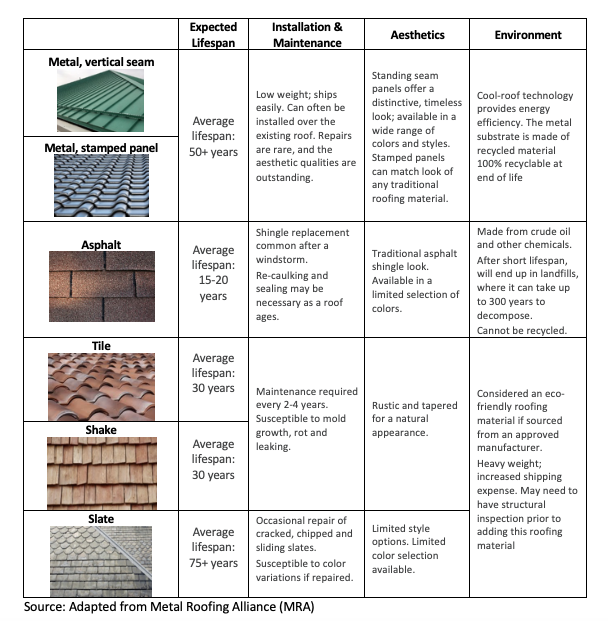
Sustainability, upcycling, downcycling, landfills … the list goes on! What is one to think when every material is touted as sustainable? Don’t believe me? Visit any material website; for example, cement/concrete, vinyl plastic, wood building products. What is one to make of all these claims—are they real? How does our industry fit in?
Although my suggestion may sound low-tech, how about if we use a little common sense to investigate the value of metal roofing and why this product has become an important disrupter and highly sustainable option in the roofing industry.
Wait, what? An important component of our own industry is the disrupter? Yes, it is (and you thought that a business disruption could only happen to you, rather than you being the disrupter). Twenty years ago, metal residential roofing was a tiny blip on the radar screen. Now it represents about 13% to 14% of the U.S. residential roofing market, a market that consumes about 15 billion square feet of material each year. Re-roofing a home accounts for about 80% of this 15 billion square feet, and this is the sweet spot for our disruptive building material. In fact, 95% of the time, metal residential roofing is used for re-roofing; the other 5% goes for new builds. Imagine that 2 billion square feet of metal residential roofing is being painted by our coil coaters. We estimate that residential metal roofing currently represents between 10% and 15% of our market. Residential metal roofing may not be the “wow” disrupter compared to mobile phones (killing the land line; killing the camera market) or software giants battling to the death (Excel deleting Lotus; Word mangling Word Perfect). In a typical industry setting, things happen more slowly and less dramatically. But no matter how you look at it, being on the giving end of disruption is sweeter than being on the receiving end.
The residential metal roofing disruption was not the result of some deep strategy session. It’s more the result of hard work, not only to develop an exceptional painted metal product, but also to introduce this “new kid” on the block. As I drive down the street in my own small town, Westerville, Ohio, with an abundance of homes built in the 1950s, I see more and more examples of old homes being re-roofed with metal. I suggested earlier that common sense explains many things, and the only way we’re taking down the Goliathan domination of asphalt shingles is homeowners deciding that metal is a superior roofing product and the cost difference is worth it.
Many associations and members of those associations have done a lot of work to get us to where we are today. As an example, the Metal Roofing Alliance created a comparison chart, which we have adapted for our purposes, so let’s have a look at it:

The decision to purchase a metal roof is likely based on common sense rather than on some deep research. Most homeowners know that shingles never last as long as the warranty says, and—let’s face it—those little pebbles that are an important component of a shingle end up in your gutter even during the first year of exposure. If a homeowner thinks in terms of sustainability, they likely will have heard messaging from the Aluminum Association and the American Iron and Steel Institute that these metals are nearly infinitely recyclable. A broken piece of slate is surely not recycled into a roofing material. Old shake roofing panels are likely converted to mulch (as is much recycled lumber). This kind of recycling is called downcycling: a material is not discarded to a landfill, and some secondary use is found for it. Taking sheets of steel or aluminum and melting them down and producing an equally useful product is called upcycling. Upcycled steel and aluminum go into premium products, not into landfills or to some secondary use.
Although all of us in the prepainted metal industry would like to see greater growth in the metal residential roofing sector, it always pays to look back to where we came from while also looking down the path forward. The future is bright. And common sense is paving the way.
To determine whether a metal roof is right for you, visit the Metal Roofing Alliance (MRA) and/or the Metal Construction Association (MCA).


May 5, 2020 at 7:50 pm
I like how you said that metal roofing can be upcycled to make premium products. This is great for any homeowner who loves the environment. You aren’t putting your metal roof pieces into a landfill or letting them become junk in a junkyard. You’re letting them be reused over and over again.
LikeLike